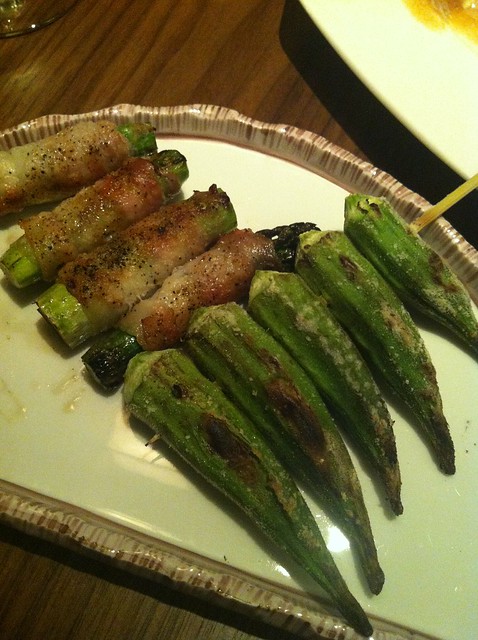When was the last time you put food in your mouth and thought, Wow, that’s exactly what I wanted to eat tonight? I felt that way with this soup. New York City has been having really humid summers that remind me of the intense sun I experienced in Laos last August. While there, I couldn’t help but eat a bowl of Laotian pho from the lady who had a stand in the street market. I sweated over my hot bowl of soup, but cooled down as soon as I got into it. No wonder people in Asia eat hot or spicy meals no matter how hot the weather is outside–sweating cools them down.
If you can’t make the beef stock here ahead of time, you’ll learn to multitask and use three of your stove’s burners at once. You’ll also just have to do some extra work removing the fat from the stock since you can’t just break the solidified fat as easily if you stored it in the fridge overnight. Note that I didn’t use any salt at all. The miso paste with the soy sauce should be enough sodium for your body in one serving. You may adjust the flavor by experimenting with the beef marrow stock and beef shank ratio when assembling the soup for your guests.
There’s a lot of ingredients involved but you only need a small amount for each. I came up with this combination because they’re what I have in the pantry. Throw in lime juice, fish sauce, and cilantro in there for a more Vietnamese flavor profile. As soon as you appreciate making a flavorful broth separate from the stock, you’ll begin to master different soup bases and will get used to trying combinations of herbs and spices you never thought possible. It’s what I like about cooking, really–the leeway you have to make adjustments and the freedom you have to change and make your favorite eater happy: you.
Ingredients:
marrow bones
udon noodles
sesame oil
bok choy
enoki mushrooms
hot chili oil
1 scallion, choppedFor the broth:
oil
beef shanks
3 cloves garlic, minced
1 small knob ginger, peeled, sliced
1 small red onion, finely chopped
1 scallion, chopped
2 Thai chiles
2 bay leaves
1 cinnamon stick, crushed
1 tsp fennel seeds
1 tsp black peppercorns
1 tbsp Sichuan peppercorns
1 star anise
1 tbsp miso paste
4 tbsps soy sauce1. Make the beef stock ahead of time by boiling water in a very large pot and cooking the marrow bones. Remove impurities that rise to the top, and simmer covered, for about 2 to 3 hours. Let cool before storing in the fridge to let the fat coagulate at the top. When ready to make the soup, remove from the fridge and then discard the fat by scooping off the solidified fat. Set aside.
2. Cook the beef shanks and make the broth. In a large Dutch oven, heat some canola oil. Brown the shanks on both sides and remove to a plate.
3. Using the rendered fat in the same pot, sauté the garlic, onion, and ginger. Add the rest of the herbs and spices and keep sautéing to make them fragrant.
4. Add back the shanks and ladle in enough beef stock to submerge them to cook the meat. Simmer for at least 30 minutes or until the meat falls off the bones.
5. When ready to assemble the soup, boil some water in yet another pot to cook the noodles per package instructions and drain to your serving bowl.
6. In a small sauté pan (or use the pot where the noodles were cooked), heat a scant of sesame oil and flash-fry the enoki mushrooms and bok choy.
7. In your serving bowl of noodles, ladle in 2 heapings of beef stock and 1 broth. Top with the vegetables, sliced meat, and hot chili oil








